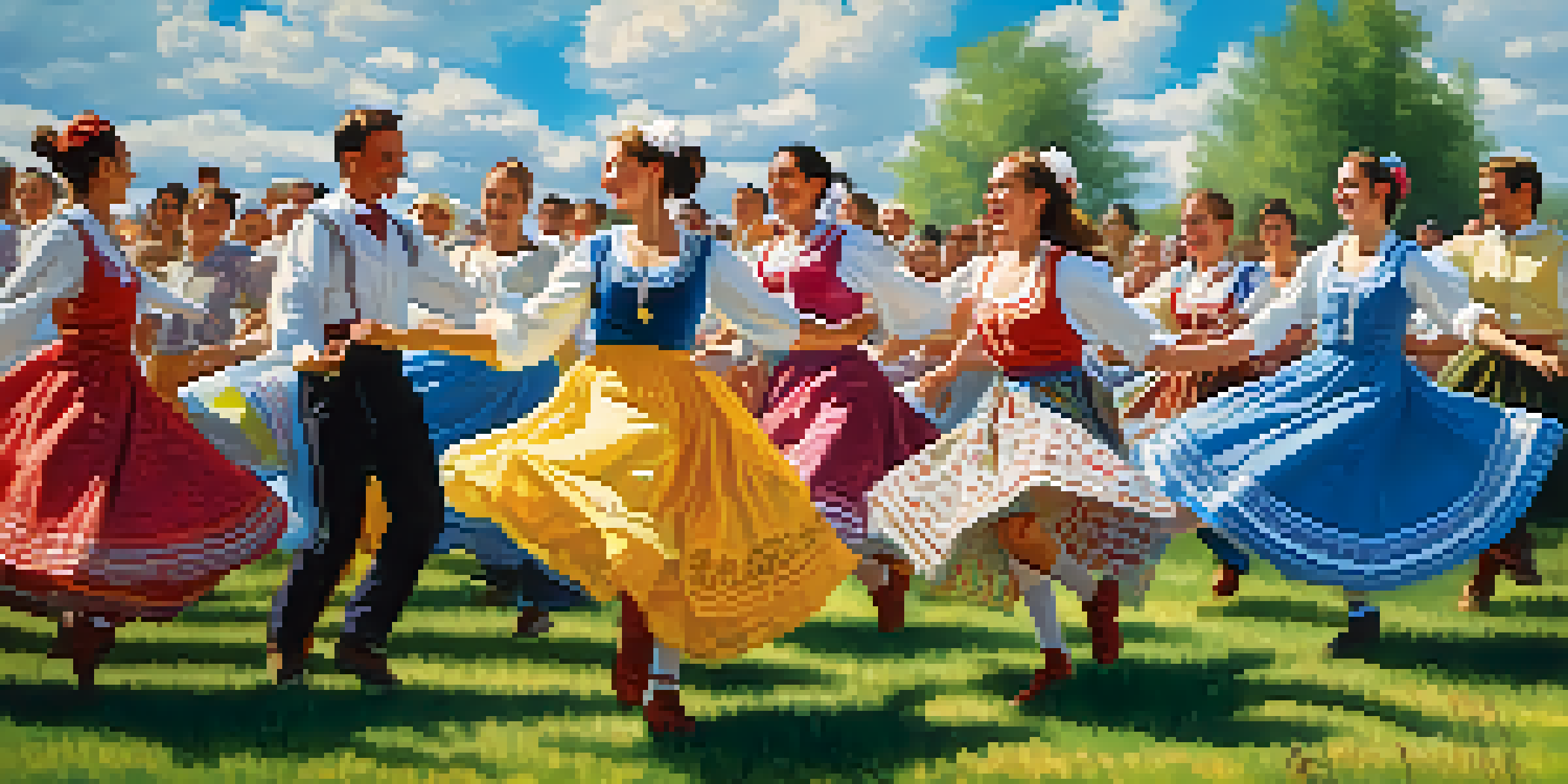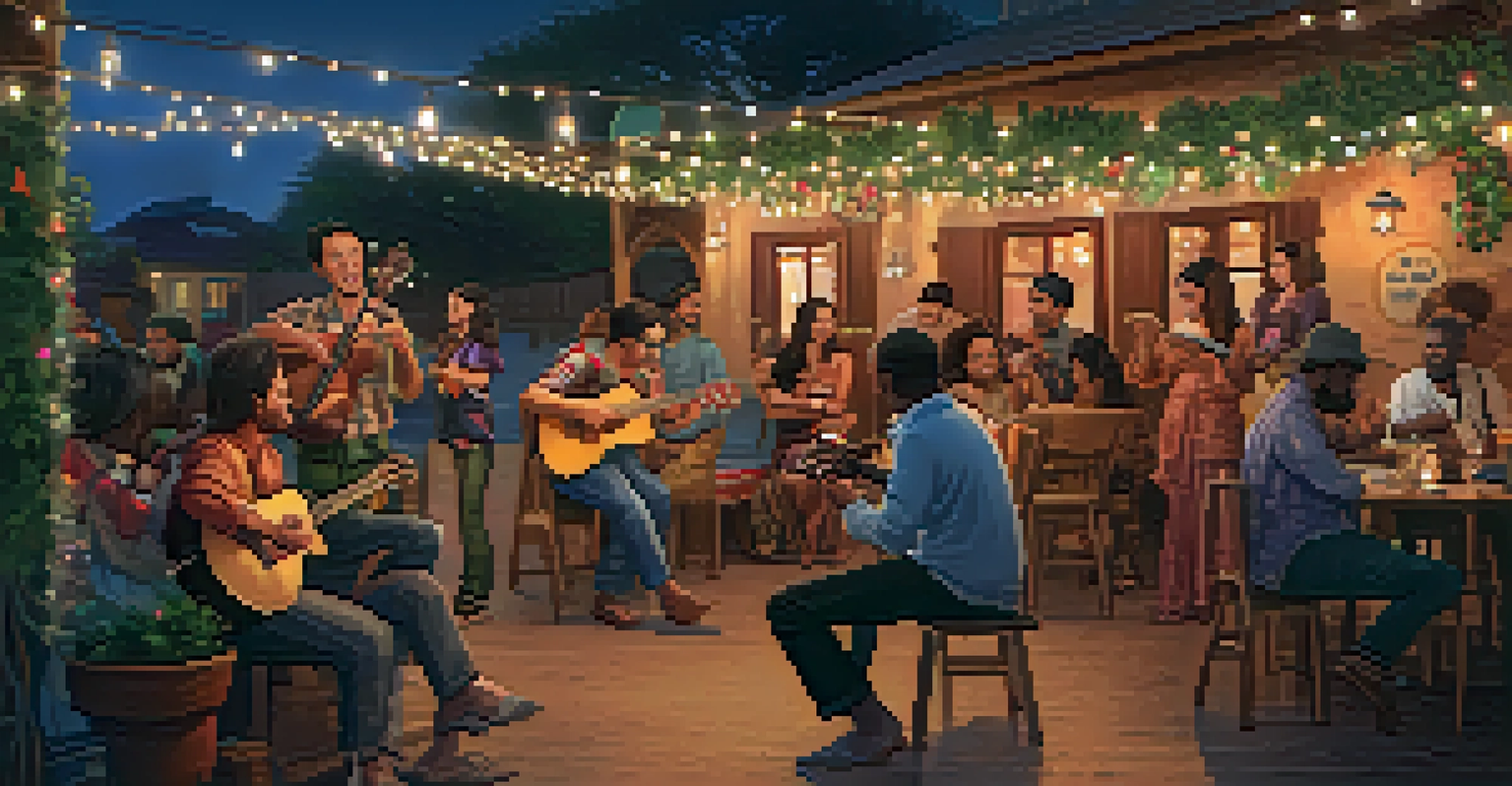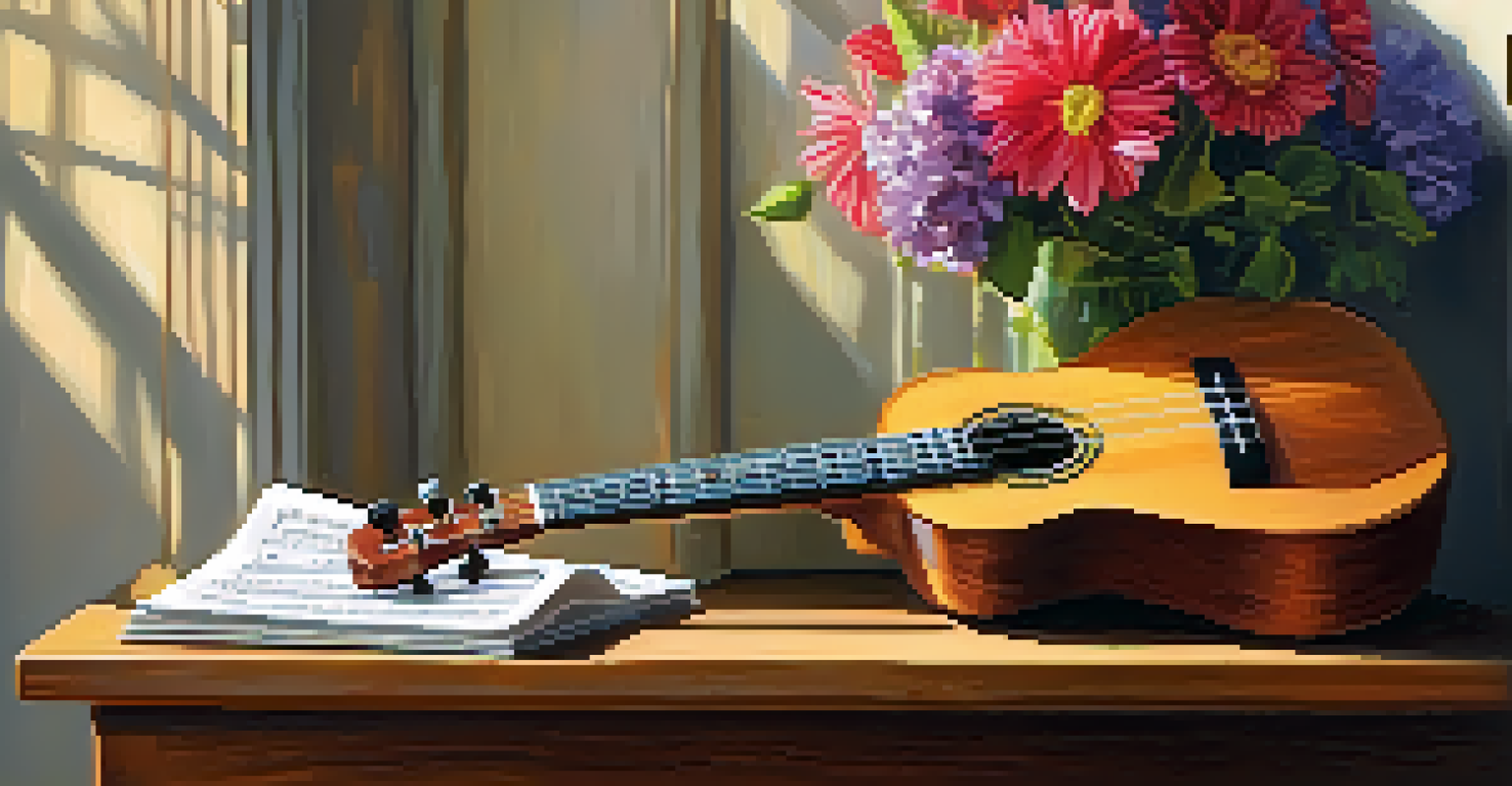Folk Dance Rhythms: Ukulele and Traditional European Styles

Understanding Folk Dance and Its Cultural Roots
Folk dance serves as a vibrant expression of community and tradition, often reflecting the history and values of a culture. Each region boasts its unique styles, movements, and music, providing a rich tapestry of human experience. For instance, dances from Eastern Europe often involve lively footwork, embodying the spirit of celebration and togetherness.
Dance is the hidden language of the soul.
The integration of dance within community events fosters a sense of belonging, allowing individuals to connect with their heritage. This cultural exchange is vital, as it keeps traditions alive while adapting to modern influences. Folk dance is not just about the steps; it's about the stories and emotions shared among dancers.
As we explore the fusion of folk dance with instruments like the ukulele, we uncover new layers of creativity. The ukulele, with its cheerful tones, brings a fresh perspective to traditional rhythms, making them more accessible to a wider audience. This blend showcases the beautiful evolution of cultural expressions.
The Ukulele: A Brief History and Its Musical Charm
Originating from the Portuguese 'braguinha,' the ukulele found its way to Hawaii in the late 19th century and quickly became a beloved instrument. Its light, cheerful sound and portability make it perfect for casual gatherings, evoking a sense of joy and warmth. Many associate the ukulele with beach vibes and laid-back tunes, but it holds a deeper musical potential.

The ukulele's four strings allow for a range of chords that can accompany various musical styles. Its versatility enables musicians to experiment with different genres, including folk, pop, and jazz. This adaptability is what makes the ukulele a fantastic companion for traditional European folk dance music, where rhythm and melody intertwine seamlessly.
Folk Dance Reflects Cultural Heritage
Folk dance embodies the history and values of a culture, showcasing unique styles and movements that connect communities.
As the ukulele continues to gain popularity worldwide, it has inspired many artists to meld it with various cultural styles. This blending creates a rich dialogue between the past and present, breathing new life into traditional sounds. The charm of the ukulele lies in its ability to connect people through music, regardless of their background.
Rhythmic Foundations of European Folk Dance
At the heart of European folk dance lies a complex system of rhythms that vary from region to region. These rhythms often dictate the dance style, with some featuring intricate footwork while others emphasize fluid body movements. Understanding these foundational rhythms is crucial for anyone looking to engage with folk dance authentically.
Music can change the world because it can change people.
For example, the lively polka is characterized by its upbeat tempo and 2/4 time signature, making it perfect for quick, spirited movements. In contrast, the waltz offers a more graceful flow, marked by its 3/4 rhythm that invites sweeping turns and elegant steps. Each rhythm tells a story, inviting dancers to express themselves in unique ways.
When the ukulele is introduced to these traditional rhythms, it can enhance the overall experience by providing a bright, rhythmic backdrop. The combination of the instrument's cheerful sound with the historical context of folk dance creates an engaging atmosphere for both performers and spectators. This fusion allows for a reimagining of classic dances, making them relevant to contemporary audiences.
Blending Ukulele with Traditional Folk Dance Styles
The process of blending the ukulele with traditional European folk dance styles is nothing short of magical. Musicians and dancers alike are drawn to the instrument's upbeat sound, which complements the lively movements of folk dance. This fusion often results in innovative performances that capture the essence of both worlds.
For instance, imagine a group of dancers performing a traditional Irish jig accompanied by the bright strumming of a ukulele. The lively tempo of the jig pairs beautifully with the ukulele's cheerful chords, inviting both dancers and the audience to join in the fun. This type of collaboration not only entertains but also celebrates cultural diversity.
Ukulele Enhances Folk Dance Experience
The cheerful sound of the ukulele adds a fresh layer to traditional folk dance, making it more accessible and enjoyable.
Moreover, this blending encourages a new generation of musicians and dancers to explore their heritage in fresh ways. As they incorporate the ukulele, they may discover new rhythms and steps that invigorate traditional practices. This dynamic exchange fosters creativity and keeps folk dance alive and relevant.
Popular Folk Dance Styles to Explore with Ukulele
There are several popular folk dance styles that can be beautifully enhanced by the ukulele. The lively tarantella from Southern Italy, for instance, has a rapid tempo that matches the ukulele’s playful strumming. When combined, they create an infectious energy that invites everyone to dance along.
Another great example is the Scandinavian polska, which features a distinctive 3/4 rhythm. Adding ukulele chords to this traditional dance not only enriches the sound but also makes it more approachable for those unfamiliar with its roots. This approachability allows for wider participation, bridging generational gaps.
Lastly, consider the French gavotte, a dance characterized by its lively tempo and unique footwork. The ukulele can provide a joyful backdrop, encouraging dancers to showcase their creativity. Each of these styles demonstrates how the ukulele can breathe new life into established traditions while maintaining their authenticity.
The Role of Community in Folk Dance and Music
Community plays a pivotal role in both folk dance and music, providing a space for individuals to come together and celebrate their culture. These gatherings foster a sense of belonging and shared identity, allowing people to connect with their roots. Whether it's a village festival or a casual get-together, the energy of folk dance is infectious.
When the ukulele is woven into these community events, it enhances the overall experience. Its inviting sound encourages participation, inviting even the shyest individuals to join in the fun. The ukulele's charm lies in its ability to break down barriers, creating a welcoming environment for all.
Community Vital for Folk Traditions
Community gatherings foster a sense of belonging and collaboration, essential for keeping folk dance and music alive.
This community aspect is essential for keeping folk traditions alive. By encouraging collaboration between musicians and dancers, we ensure that these art forms continue to thrive. As new generations embrace folk dance, they not only honor their heritage but also contribute to its evolution.
The Future of Folk Dance and Ukulele Integration
As we look to the future, the integration of ukulele with folk dance shows no signs of slowing down. Musicians and dancers are increasingly experimenting with this fusion, leading to innovative performances that captivate audiences. This evolution keeps folk traditions relevant in a rapidly changing world.
New technologies and platforms allow for wider dissemination of folk dance and music, inviting more people to participate. Online tutorials and social media have made it easier for individuals to learn and share their experiences with others. This accessibility is vital for the growth of these cultural expressions.

Ultimately, the combination of ukulele and folk dance represents a beautiful dialogue between tradition and modernity. As artists continue to explore this relationship, we can expect to see even more creative interpretations that honor the past while embracing the future. The journey of folk dance and music is ongoing, and we’re all invited to be a part of it.